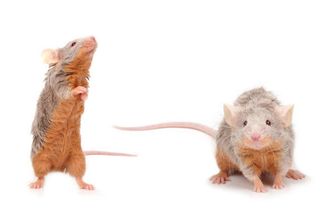Drug Boosts Body's Natural Cannabis, Eases Fear in Mice

A drug that bolsters the body's cannabis-like chemicals can ease anxiety in mice, according to a new study that suggests the same brain chemistry influences how people cope with stress.
The body releases chemicals called endocannabinoids, so named because they act on the brain in almost the same way as cannabis, or marijuana, does. Much like marijuana, endocannabinoids promote relaxation. The new research finds that by halting the enzyme that breaks down an endocannabinoid called andamide, scientists can quickly train mice to get over traumatic experiences.
More importantly, people whose genes ultimately produce less of the andamide-eating enzyme have an easier time remaining cool under pressure, the researchers report today (June 12) in the journal Molecular Psychiatry.
"What is most compelling is our ability to translate first from mice to human neurobiology and then all the way out to human behavior," Ahmad Hariri, a neurobiologist at the Duke Institute for Genome Sciences & Policy, said in a statement. "That kind of translation is going to define the future of psychiatry and neuroscience."
Getting over fear
Hariri and his colleagues focused on the enzyme fatty acid amide hydrolase, or FAAH. This enzyme breaks down andamide, which is already known to influence fear behavior. [Trippy Tales: History of 8 Hallucinogens]
The researchers used a breed of mice that shows normal fear responses but has a hard time learning when a once-dangerous situation is no longer scary. They trained the mice to fear certain tones by playing the tones and then applying small electric shocks to the rodents' feet. Later, some of the mice were trained to forget their fear in sessions where they heard the tones but did not feel a shock.
Sign up for the Live Science daily newsletter now
Get the world’s most fascinating discoveries delivered straight to your inbox.
The researchers injected a group of these mice with a chemical called AM3506 before the anti-fear training. AM3506 blocks the action of FAAH, preventing the body from getting rid of its andamide. Other mice got the injection without the training or got the injection and were tested on a series of non-fear-related behaviors.
The results showed that mice that were injected and then taught the tones were safe showed a faster recovery from fear than their brethren that didn't get the drug. The injections had no effect on non-fear behaviors, nor did they numb fear in situations where the mouse hadn't been taught that tones no longer heralded shocks.
The researchers traced the drug's effect to the amygdala, an almond-size brain region important in processing fear and emotion.
The human connection
To link the mouse work with hope for anxious or traumatized humans, Hariri and his colleagues recruited 81 middle-age adults to look at pictures of angry and fearful faces while in a functional magnetic resonance imaging machine (fMRI). The fMRI recorded activity in the amygdala as the participants became more and more used to looking at the emotionally charged faces.
As the experiment went on, everyone's amygdala stopped responding as strongly to the faces. But this gradual quieting happened fastest in the people who carried less-active FAAH genes.
Next, Duke University's Terrie Moffitt and Avshalom Caspi compared FAAH genes and personality in a group of 881 New Zealanders who have been part of a long-running study since the 1970s. They found that the most chill, stress-free people in the study were generally those with quiet FAAH genes.
The findings could help explain why some people are more susceptible to anxiety and post-traumatic stress disorder (PTSD) than others, the researchers said. At some point, scientists might even be able to offer new drug treatments for PTSD and other fear-related disorders.
Follow Stephanie Pappas on Twitter @sipappas or LiveScience @livescience. We're also on Facebook & Google+.

Stephanie Pappas is a contributing writer for Live Science, covering topics ranging from geoscience to archaeology to the human brain and behavior. She was previously a senior writer for Live Science but is now a freelancer based in Denver, Colorado, and regularly contributes to Scientific American and The Monitor, the monthly magazine of the American Psychological Association. Stephanie received a bachelor's degree in psychology from the University of South Carolina and a graduate certificate in science communication from the University of California, Santa Cruz.
Most Popular


